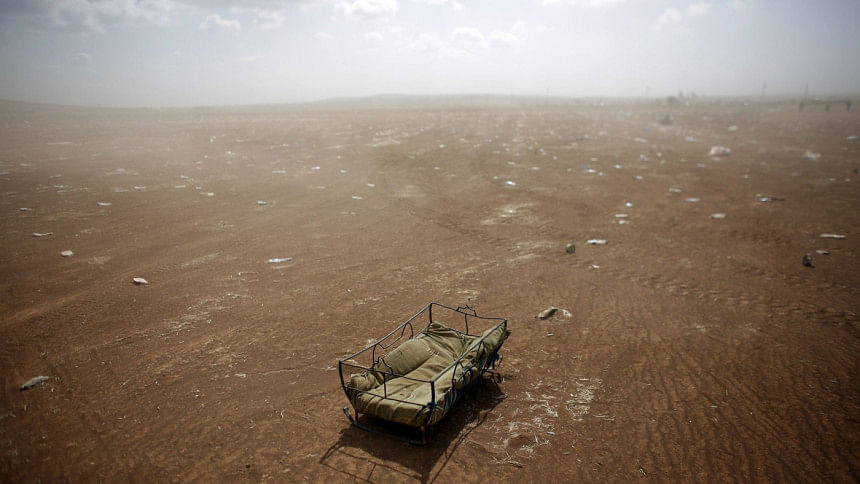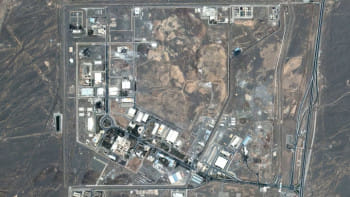Global warming sets the stage for war

The first time I encountered the concept of a war for the environment was in the Command & Conquer: Tiberian Series of strategy games. In that near-future world, strange crystals fall from space that multiply and render local soil deadly and unusable. As the so-called Tiberium spreads across the Earth, human civilisation fractures, and most of the developed world unite to safeguard their territories while the Third World is ravaged by the crystals; only a shadowy apocalypse cult with a global terror network offers salvation to the masses. At the time I thought it chilling, though certainly not prophetic.
Times change and the vision first outlined in a 1995 video game seems increasingly possible. Conflict driven by drastic environmental degradation is our present and our future, and it did not take space crystals to do it.
Climate change is long-term and at the ground level it is subtle. People do not react to its effects in the same way they might do to a sudden collapse in stock prices or an attack from another ethnic group. Its role in conflict generation is thus rarely overt, which can at times lead to this role being dismissed. However, an indirect effect is still an effect and climate change has had a hand in so many flashpoints across the world that it is high time its influence is acknowledged. It is imperative that this be done in an era when the climate change denial lobby is gaining, not losing, grip on the reins of power. We, Bangladeshis, especially cannot afford to stick our heads in the sand any longer.
Climate change is global but its effects are not homogeneous. Throughout history we have seen examples of fluctuations that have benefited certain parts of the world over others. Climate change affects local resources and these changes inevitably have conflict-generation implications. Generally warming effects reduce resource availability in equatorial regions: consider the millennia-long drying and southward drift of the Sahara desert, a process that continues at present. In contrast it was a period of general warmth that made possible the great age of Viking exploration that led to the founding of the first European colonies in North America, and a 500-year period of mild weather before the 11th century set Europe up well. Warming periods in the colder climates open up new resources and conflicts arise when the local societies compete to exploit them. In the hotter parts of the world the competition is over the control of what resources are left, and there is spill-over across borders. In general, warming in the colder regions has a more indirect hand in conflict generation, and primarily impacts inhospitable zones. In warmer climates the impact is felt directly by affecting precipitation and evaporation, robbing regions of existing water resources. Furthermore, climate change generates less conflict if there is room for people to migrate and adjust.
Good examples of these principles in action are the collapse of the Mayan and Anasazi civilisations: drought upsetting the power balance between a civilisation's city-states and prompting lethal internal conflict. The volcanic eruption of Indonesia's Mount Tambora in 1815 threw ash clouds that blocked the sun's rays worldwide, working with a centuries-long cold front to create the 'year without a summer'. This had a terrible impact in crowded Europe, which was already reeling in the aftermath of the Napoleonic Wars. Result: famine, riots and arson. In Asia, late monsoons resulted in terrible floods in China and India, sparking a cholera epidemic stretching from Bengal to Moscow. In the United States, however, westward migration was available as an option and encouraged; this acted as a social safety valve that prevented many of the worst experiences of the Old World.
The international community wrings its hands over whether or not climate change sparked the conflict in Syria. Environmental migrants arrive in the developed countries, creating new lines of conflict. Nationalism and isolationism begin to creep into the mainstream, closing the door to these refugees.
The lessons of history do not bode well for us in the Third World in this era of anthropogenic (man-made) climate change. Our countries are poor and crowded and hot. It is no coincidence that out of 38 cases of environmental migration analysed by Dr Rafael Reuveny in 2007, only two came from developed countries. Two cases had North American origins, one was Russian; none were European. Depressingly, of all the episodes of migration studied by Reuveny, the highest numbers of migrants per episode were from Bangladesh; 12-17 million people seeking refuge from food and water scarcity. We often imagine that global warming will cause our nation to sink, and that is the principal danger. Yet the steady starvation of our rivers in a heating world, coupled with India's stranglehold on the Ganges, has already been grinding away at us. Confirmed reports of illegal immigration to India exist as far back as 1983, and the relationship between migrant and host has not been peaceful. Of course, not all migration is external: there is a sensitive region within our own borders that sees its share of ethnic conflict due to demand for land away from the drying delta. Farakka casts a long shadow.
The world isn't blind. In 2007, the former Secretary-General of the UN, Ban Ki-moon, described Darfur as an 'ecological crisis'. Environmental pressure driving conflict has periodically been in the spotlight for decades, notably in Rwanda. Resource degradation is a Pandora's box that lays bare the divides between class, ethnicity and a whole host of other differences people cite as their cause for war; global warming is degrading resources worldwide, but particularly affects the least developed countries. In contrast, the developed countries in their colder climates enjoy relative security and may stand to benefit from warmer temperatures – to make matters worse these are the nations with the greatest cumulative contribution to anthropogenic climate change.
The international community wrings its hands over whether or not climate change sparked the conflict in Syria. Environmental migrants arrive in the developed countries, creating new lines of conflict. Nationalism and isolationism begin to creep into the mainstream, closing the door to these refugees. The United States, the greatest carbon emitter in history, has elected a border-closer and climate change denier. A vision of the future is being sketched here, and it is bleak for us.
Yet our treatment of the refugees at our own doorstep makes us poor players of the role of the tragic victim.
The writer is an artist with a degree in Economics from BRAC University.

 For all latest news, follow The Daily Star's Google News channel.
For all latest news, follow The Daily Star's Google News channel. 



Comments